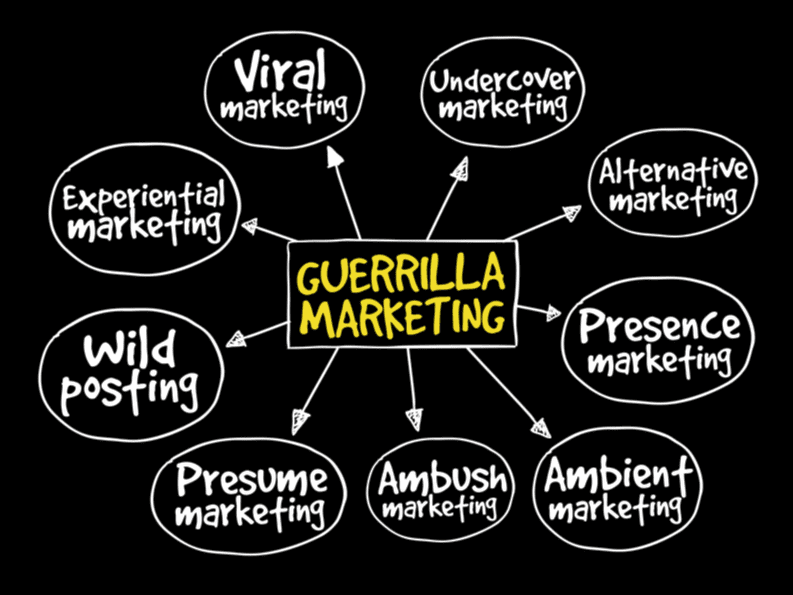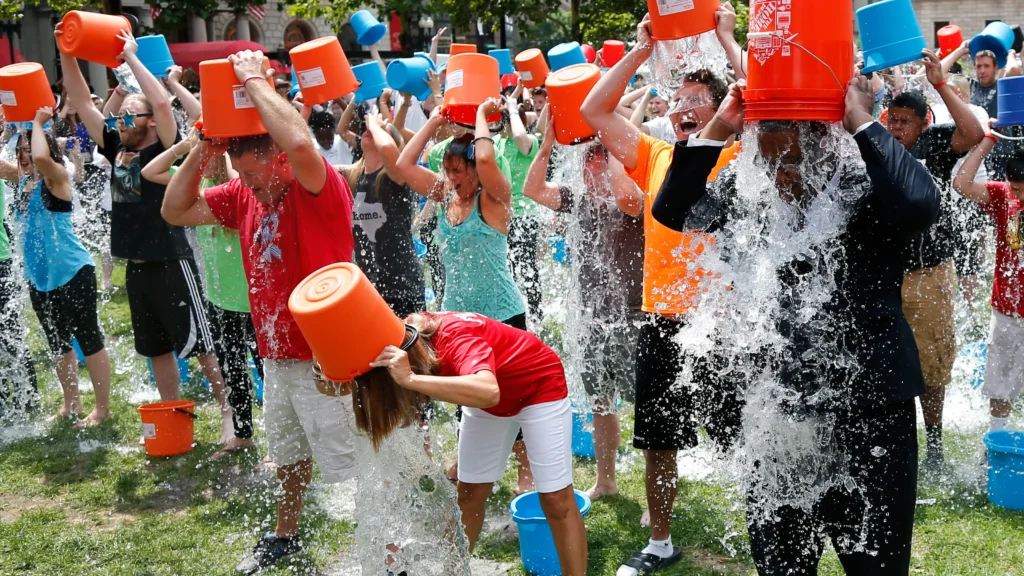
In the dynamic world of marketing, where competition is fierce and consumer attention spans are fleeting, thinking outside the box is critical for success. While traditional channels like social media, email, and television advertising remain valuable, it’s the brands that dare to be different that often leave a lasting impression. In this post, we explore unconventional marketing strategies that break away from the norm and captivate audiences in unexpected ways.
1. Guerilla Marketing: Taking to the Streets

Guerrilla marketing is the art of surprise – unconventional and often low-budget tactics that create a buzz around a brand. Let’s examine the impact of guerrilla marketing through case studies that not only caught people off guard but also sparked widespread interest and conversation. By thinking outside the traditional advertising box, these brands managed to create memorable moments that lingered in the minds of their audience.
- The ALS Ice Bucket Challenge – A Viral Sensation for a Cause: The ALS Ice Bucket Challenge took the world by storm in 2014, showcasing the power of guerrilla marketing for a noble cause. Participants were challenged to dump a bucket of ice water over their heads, raising awareness and funds for Amyotrophic Lateral Sclerosis (ALS). The challenge quickly went viral, with celebrities, politicians, and ordinary people joining in. This grassroots campaign not only raised millions for ALS research but also demonstrated how a simple, unconventional idea could captivate a global audience and spark widespread engagement.
- Red Bull – Breaking Barriers with a Leap from the Stratosphere: Red Bull’s Stratos project exemplifies guerilla marketing on an epic scale. In 2012, Austrian skydiver Felix Baumgartner ascended to the edge of space in a helium balloon and then free-fell back to Earth, breaking the sound barrier in the process. Red Bull live-streamed the event, creating a jaw-dropping spectacle that captivated millions worldwide. This daring stunt not only showcased Red Bull’s commitment to extreme experiences but also positioned the brand as a leader in adventurous marketing, leaving a lasting impression on viewers globally.
- IKEA’s Guerrilla Campaign – Turning Commuters into Nappers: IKEA, the Swedish furniture giant, ingeniously turned an ordinary Parisian metro station into a makeshift bedroom to promote its bedroom furniture. Complete with beds, nightstands, and even sleeping commuters, the guerilla campaign surprised and delighted passersby. The event was captured on camera and shared across social media, generating significant buzz. This unconventional approach not only showcased IKEA’s creativity but also provided a memorable and shareable experience for consumers, reinforcing the brand’s association with comfort and home.
- The Flash Mob by T-Mobile – Spontaneity in the Square: T-Mobile’s flash mob at Liverpool Street Station in London in 2009 is a classic example of guerilla marketing. A seemingly ordinary train station suddenly transformed into a lively dance performance involving hundreds of people. The event was captured on video and shared online, creating a viral sensation. T-Mobile successfully turned a public space into a stage, surprising and engaging commuters in a way that traditional advertising couldn’t. This flash mob demonstrated the impact of spontaneity and creativity in capturing the attention of a diverse audience.
While these case studies may be a little more on the extreme side in comparison, they highlight how strong and effective guerrilla marketing tactics can be, and will hopefully spark some creatives ideas on guerrilla marketing tactics you could implement with your business at a community, state or national level!
2. Interactive Content: Beyond the Click

Static content is evolving into interactive experiences that go beyond traditional engagement metrics. Brands are increasingly leveraging quizzes, polls, augmented reality, and other interactive elements to forge meaningful connections with their audience. Let’s explore some compelling case studies that showcase the power of interactive content.
- Buzzfeed’s Quizzes – Personalization in Digital Media: Buzzfeed, a pioneer in the realm of online quizzes, has demonstrated how interactive content can be a powerful tool for audience engagement. Their quizzes range from the humorous “Which Disney Character Are You?” to the informative “What Career Should You Actually Have?” These quizzes not only entertain but also tap into the desire for self-discovery, encouraging users to share their results on social media. Buzzfeed’s success highlights the potential of interactive content to capture attention, drive social sharing, and create personalized digital experiences.
- National Geographic’s Augmented Reality – Bringing Stories to Life: National Geographic has embraced augmented reality (AR) to enhance the storytelling experience for its audience. Through AR features in its magazines and mobile apps, National Geographic brings static images to life. Readers can use their smartphones or tablets to unlock additional content, such as 3D models, videos, and interactive maps. This immersive approach not only enriches the reading experience but also showcases how traditional media can seamlessly integrate with interactive technology to engage and educate audiences in new and exciting ways.
- Spotify’s Personalized Playlists – Music Tailored to Your Tastes: Spotify has revolutionized the music streaming experience by offering personalized playlists based on user preferences and listening habits. Using sophisticated algorithms, Spotify curates playlists like “Discover Weekly” and “Daily Mixes,” providing users with a tailored selection of music. By making the listening experience highly personalized, Spotify keeps users engaged and encourages them to explore new artists and genres. This case study exemplifies how interactive content, driven by data and personalization, can significantly enhance user satisfaction and retention.
- The New York Times’ “Snow Fall” – Interactive Storytelling Redefined: The New York Times set a new standard for online journalism with its multimedia feature “Snow Fall: The Avalanche at Tunnel Creek.” This long-form article seamlessly combines text, images, videos, and interactive elements to tell a compelling story. Readers can navigate through the content at their own pace, exploring additional information and multimedia elements. “Snow Fall” not only garnered critical acclaim but also demonstrated how interactive storytelling can captivate audiences in the digital age, transforming a traditional news article into an immersive experience.
In summary, these case studies underscore the versatility of interactive content in capturing attention, providing personalized experiences, and redefining how audiences engage with digital media. As technology continues to advance, the potential for innovative and interactive content strategies will only grow, offering brands new opportunities to connect with their audience on a deeper level.
3. Collaborative Marketing: Joining Forces for Impact

Collaborative marketing involves partnerships between brands, events, or influencers, creating a symbiotic relationship that yields mutual benefits. These collaborations often transcend traditional boundaries, tapping into new audience segments and leveraging each other’s strengths. Let’s explore some compelling case studies that highlight the power of collaborative marketing.
- Nike x Off-White – Blurring Fashion and Streetwear Boundaries: The collaboration between athletic giant Nike and high-fashion streetwear label Off-White, led by designer Virgil Abloh, exemplifies the fusion of distinct styles to create something entirely new. The partnership resulted in limited-edition sneakers that became highly coveted by sneaker enthusiasts and fashion-forward consumers alike. By merging the worlds of athletic performance and high-end fashion, Nike and Off-White not only reached new audiences but also generated substantial buzz and anticipation for each release. This collaboration showcases how brands from different sectors can come together to create unique and desirable products, enhancing their respective market positions.
- Spotify x Starbucks – Elevating the Coffee Shop Experience: In a harmonious collaboration, music streaming giant Spotify and coffeehouse chain Starbucks joined forces to enhance the coffee shop experience. Starbucks baristas gained the ability to influence the in-store music playlist through a dedicated Starbucks app integration with Spotify. This collaboration not only curated an enjoyable ambiance for customers but also allowed Starbucks to leverage Spotify’s vast music library. By creating a seamless connection between the coffee-drinking and music-listening experiences, both brands benefited from an enhanced customer experience, increased foot traffic, and positive brand associations.
- GoPro x Red Bull – Thrills and Spills in Extreme Sports: The partnership between action camera manufacturer GoPro and energy drink brand Red Bull is a match made in extreme sports heaven. Red Bull, known for its sponsorship of adrenaline-fueled events, collaborated with GoPro to capture and share the exhilarating moments experienced by extreme athletes. This collaboration extended beyond traditional sponsorship, as GoPro cameras became an integral part of Red Bull’s content creation strategy. The synergy between the two brands not only reinforced their positions in the extreme sports community but also showcased the power of collaborative marketing in authentically capturing and sharing compelling stories.
- Airbnb’s Neighborhood Support Hotline – Collaborating for Community Impact: In response to the COVID-19 pandemic, Airbnb collaborated with the World Health Organization (WHO) and other health authorities to establish a Neighborhood Support Hotline. This initiative aimed to provide reliable information to hosts and guests, ensuring that everyone involved in the Airbnb community stayed informed about health and safety guidelines. By collaborating with global health organizations, Airbnb demonstrated a commitment to community well-being during a challenging time. This collaboration went beyond marketing products or services, emphasizing a shared responsibility for the safety and health of the community.
These case studies showcase the diverse opportunities and positive outcomes that arise from collaborative marketing efforts. By combining strengths, sharing audiences, and creating unique experiences, brands can amplify their impact and establish meaningful connections with consumers. Collaborative marketing goes beyond traditional partnerships, fostering innovation and collective success in the dynamic landscape of the business world.
Conclusion
In a world saturated with marketing messages, standing out requires creativity, innovation, and a willingness to break free from conventional thinking. Unconventional marketing strategies not only capture attention but also foster a sense of excitement and curiosity. As marketers, embracing these unconventional approaches allows us to connect with our audience in ways that transcend the limitations of traditional channels. So, dare to be different, think outside the box, and watch your brand leave an indelible mark on the minds of consumers.
If you are interested in discussing a marketing strategy that is tailor-made for your business model with our marketing experts, feel free to contact us!







